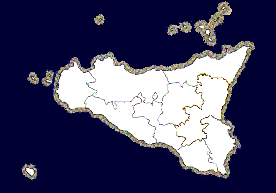


Pretty much going counter-clockwise around Sicily, we started our tour on the eastern edge of the island in Catania, the second biggest city in Sicily and usually the hottest (like 104F in the high summer -- but our days were sunny and pleasant). The town is reasonably flat even though it is built on the slopes of Mount Etna which has treated the place rather disdainfully, including dumping lava on it several times. The natives responded by using a lot of lava stone in the buildings and sidewalks which gives the town sometimes a dark tinge. There is a lot to see (but not necessarily do) in this town, but we didn't get to spend much time there even though we visited it twice. We will go back!
We got into town early and went for an afternoon walk including a local market where prices were really low. (Generally we found low prices in Sicilian spots that didn't cater to tourists). Turns out most stores are closed in Sicily between 1PM and 4PM but the market was lively and we hardly noticed, especially after finding an outdoor cafe for a calzone-like snack and a beer.
We first stumbled into the Bellini Square (which we thought was in honor of our favorite baroque sculptor) but instead was dedicated to a local boy composer of ten operas. Vincenzo Bellini who was born in Catania in 1801 but moved to Paris where he died 34 years later in a suburb now housing the biggest shopping center in Europe.
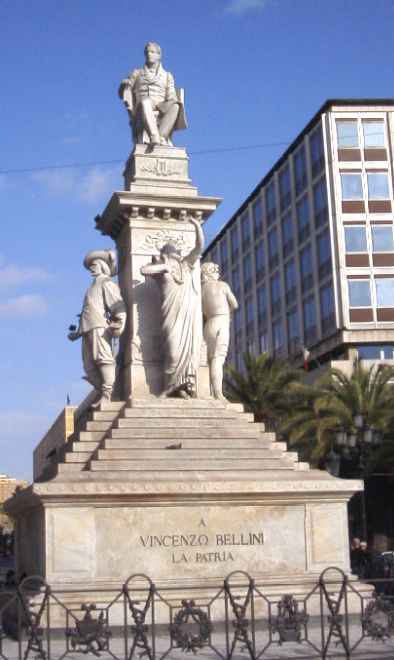
Below Bellini's statue, the memorial features characters from his operas. Catania is quite proud of Bellini and has named its great opera house after him as well as a park, museum, and who knows what else. Guide books show that the opera house (built about 100 years ago) is spectacular inside but we didn't get to see it; so you don't either but here's what the outside looks like:
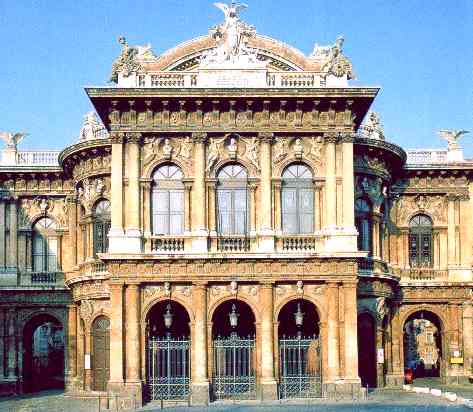
Nearby were (very) partial ruins of a Roman theater, one of two in the town. This one held about 14000 people. This one is built of lava stone but not much is left of it. We saw much better later on the trip.
catania-colesium.jpg
Next we made our way to Villa Bellini, a large park with great views of Mount Etna and careful landscaping. The picture of Pietrina at the top of the page was taken there. Here's another picture of the kiosk in the park at the top of its hill. You may be able to make out the sidewalk made of cemented white and black (lava) stones.
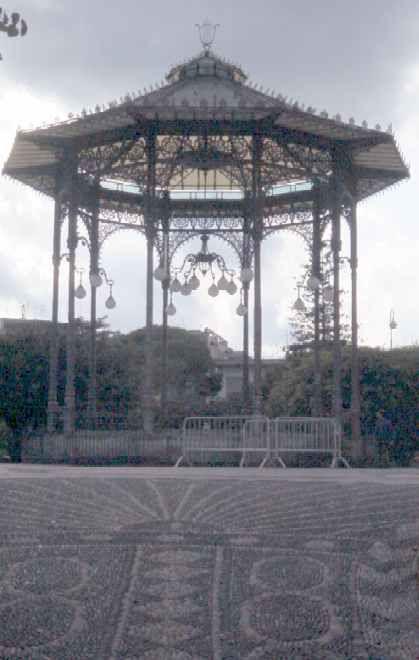
Eventually we stumbled into the main square (Piazza del Duomo) which contains the "symbol" of Catania, the elephant (don't ask me why). The elephant is black because he is carved of lava stone which you find in abundance in Catania, thanks to an ever fresh supply Mount Etna delivered free. This statue is modeled on the Piazza Minerva in Rome (near the Pantheon) which has another elephant designed by another Bellini (Giovanni, whose work we fell in love with during our Rome trip in 1998). The Roman elephant holds up a sixth century BC obelisk.
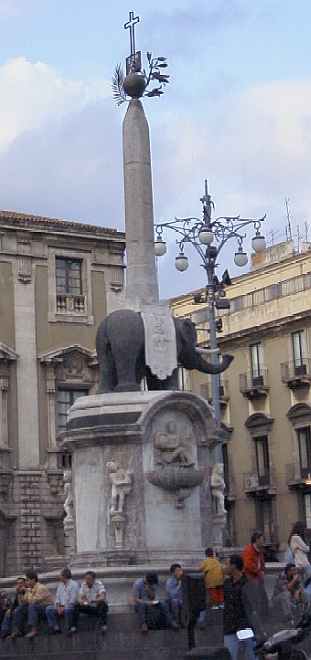
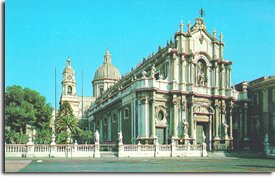
Across the street from the elephant is the cathedral (Duomo), originally built by the Normans in the 11th century on the site of probably a Roman temple. Unfortunately (or fortunately if you hate Norman architecture which is pretty unimaginative and ponderous from the oustide), the Norman structure was nostly wiped out by the 1693 earthquake. (During recent restorations, builders are still finding pieces of it). It was rebuilt in Baroque style including a later front fašade by an architect called Vaccarini who did several churches in this part of Sicily. Unfortunately we weren't allowed inside because, like a lot of the churches in Italy, it is undergoing repairs.
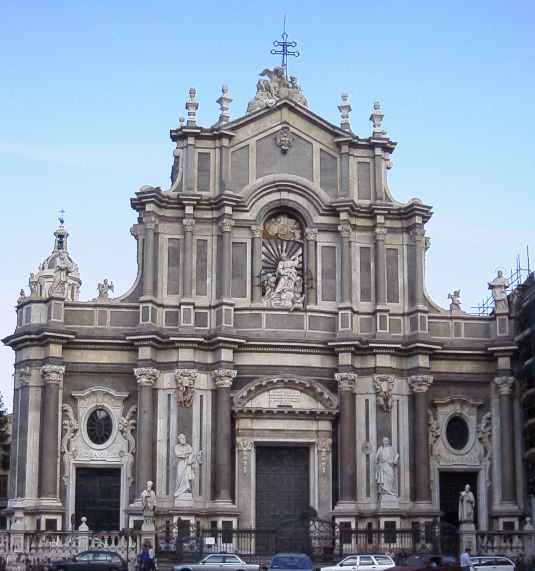
The church is dedicated to St. Agatha, the patron saint of breast cancer, who was martyred in the town during the third century.
On the other side of the elephant is a prettier fountain, the Fontana dell' Amenano, named after a nearby river that gives it water. The water falls on this fountain in a very delicate manner.

Moving south from here, we encountered many churches, a few of them open. Our favorite was St. Francis of Assisi. Here's a picture of its inside where they rolled out the red carpet for us. This church also contains the remains of Fredrick III's queen with a statue of her sleeping under a side altar. Apparently sermons then were not unlike those of today:

Along the niches to the sides, are six (of eleven total) floats which are maneuvered by various groups through the streets the annual St. Agnes religious festival. (Most towns in Sicily seem to have religious feasts where most of the townspeople take to the streets and parade for days.) Here's one of the floats which are stored the rest of the year right in St. Francis church: (note the rollers on the bottom).
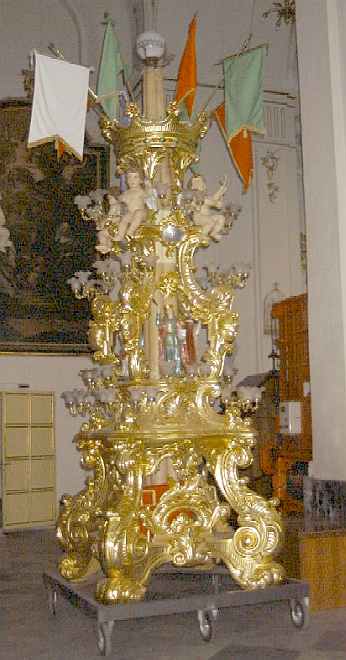
We ended the Saturday night walking along Catania's "strip," Via Etnea, where as night fell, the Italians came out in droves to see and be seen in their passeggiata (stroll). The place seemed to be getting lively but we had to get back to our hotel for dinner and the tour kickoff. The next morning we were on our way to Etna.
We returned the following Friday and had a little time to see a few sights we missed the first time such as the Norman fort, Castello Ursino, built by Frederick II of Swabia on the sea shore in 1239. Etna moved the shore several blocks away about 300 years later. Over the years it has been a military barracks and a prison (including Austrian prisons-of-war during WWI.) It now houses one of the city museums which (of course) was closed for repairs. As you can see from the front, many delicate statues that we think (but could not confirm) are by another Catania boy named Emilio Greco (1913-1995) who has his own museum elsewhere in the town.

If you want to follow our steps, you now have two choices. After the first visit, we journed to Mount Etna and you can follow us by clicking here. On our return a week later, we ventured forth on our own tour of Baroque Sicily, the Southeastern part of the island which was pretty much destroyed by an earthquake in 1693 and rebuilt by Baroque architects. Please join us by clicking here:
Where do you want to go today? Here's a few choices:
